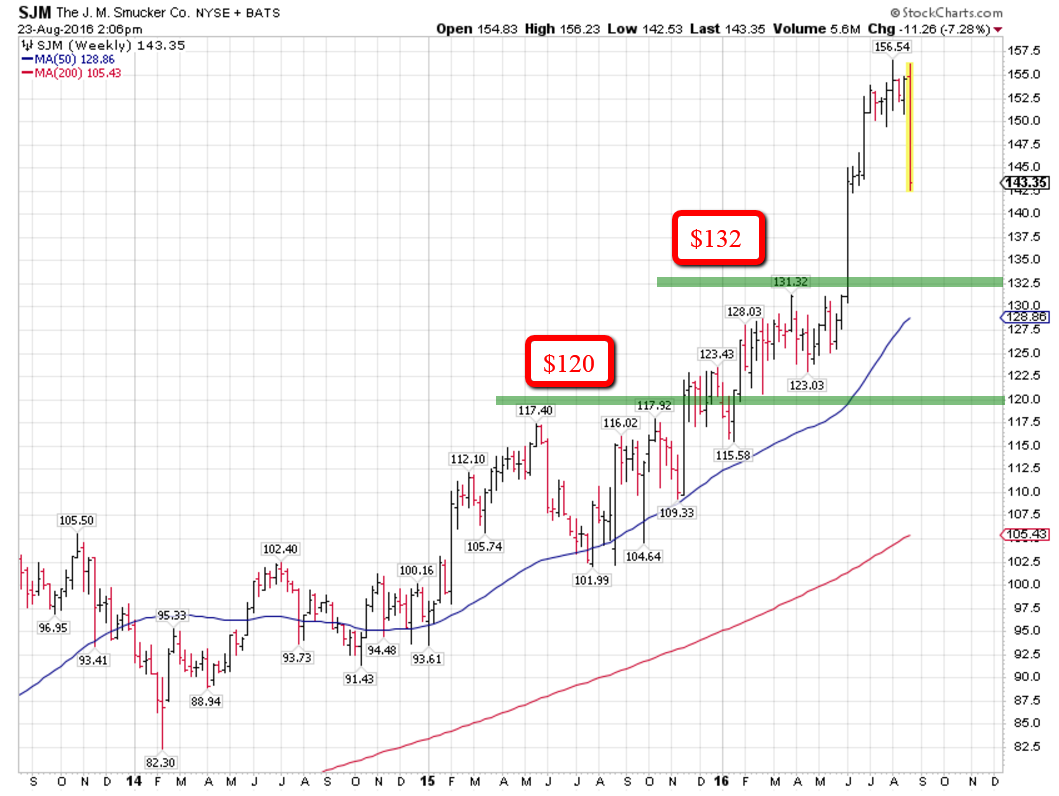
JM Smucker Company (NYSE:SJM) reported a miss on revenues while maintaining it’s EPS outlook. The shares are down about 8% today. I’ve long been a fan, and a shareholder. Strong balance sheet, that’s been a steady and consistent out-performer, in a “safe” industry.
The stocks had quite a run up leading into today’s earnings. It was up 26% YTD and even after today’s drop it’s still outperforming the S&P 500, at 7.61% YTD, by a wide margin. The company has a long successful track record to allow one quarter to derail any of that. In my opinion this has more to do with the run up leading into this report. It’s great to see a stock you already own go “parabolic”. But oftentimes that just means investors are pulling future returns forward into the present and the result is usually either sub-par performance going forward (as the prior gains are “digested”) or worse, a major swing high before a significant pullback (as the stock/asset class becomes significantly overvalued).
A major daily move like this is almost never resolved in one day. Which leads me to believe there will be further downside in the days/weeks to come. Projected support comes in at $132 and $120 respectively. If your bullish on the stock, these might be good price points to enter.
Perhaps the better question is what can we learn from this? While there is no one perfect way to invest or trade, this is what has worked for me.
- Never chase momentum
Nothing goes up (or down) forever. Patience is critical to successful investing and it’s one of the hardest elements to master. A stock actually becomes more risky the higher it goes and less risky the lower it goes. This goes against our natural instincts but it’s the truth.
2. Never over-allocate to any one individual company
How many blue chip companies over the last 50 years are no longer relevant? My personal rule is to never allocate more than 5% to any one individual company. This way even a 50% drop in the company’s stock would only have a 2.5% effect on your total portfolio.There are some great companies that look like they may be around forever. But the truth is no one knows what the future holds with any certainty. Don’t allow your pride to make you think otherwise.
3. Equal weightings for all companies in your portfolio
While this is not a hard and fast rule for me, I do think the theme is relevant. This sort of piggy backs off of #2. I’m not interested in trying to figure out what company may or may not outperform the other each and every year. To me this is a classic “paralysis by over analysis” and I think it does more harm than good. When you overweight certain stocks over another it becomes more emotional. You become more emotionally connected in the outcome of the stock and this can make for some bad judgement calls. Locate some good companies and buy them at good prices and in equal size portions. Let the chips fall as they may. After all there is much outside of our control in the short term anyway.
4. Stay balanced
There is much debate between passive and active management. The problem I find is that most people take one side over the other and become entrenched in that viewpoint. Personally I think both sides have excellent points and I use a combination of passive index ETF’s and active stock picking in my approach.
There is a growing trend in this “buy and hold forever” philosophy. This is mainly the product of a seven year bull market. Investors can certainly do better than this approach but it takes time and effort (nothing good is easy).
(Disclaimer: Long SJM)
